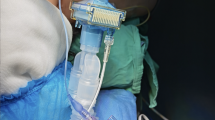Abstract
Postoperative respiratory complications related to endotracheal intubation usually present as cough, sore throat, hoarseness. The aim of the study was to examine the effects of endotracheal tube cuff pressure changes during gynecological laparoscopic surgery on postoperative sore throat rates. Thirty patients who underwent gynecological laparoscopic surgery and 30 patients who underwent laparotomy under general anesthesia with endotracheal intubation were included. After induction of general anesthesia and endotracheal intubation, the cuff was inflated to 25 mmHg. At 5, 15, 30, 45 and 60 min after endotracheal intubation, cuff pressure and peak airway pressure were recorded. At 2 and 24 h after surgery, the patients were assessed for complaints of a sore throat. In patients who underwent laparotomy, cuff pressure and peak airway pressure did not change significantly at different time points after intubation. In patients who received laparoscopic surgery, cuff pressure and peak airway pressure were significantly increased compared to initial pressure at all examined time points. In both groups, the endotracheal tube cuff pressure and peak airway pressure were significantly correlated (R = 0.9431, P < 0.01; R = 0.8468, P < 0.01). Compared to patients who had undergone laparotomy, patients who had undergone laparoscopic surgery showed significantly higher sore throat scores at both 2 and 24 h after surgery (P < 0.01). Pneumoperitoneum and Trendelenburg position may increase airway pressure and cuff pressure, resulting in increased incidence of postoperative sore throat.
Similar content being viewed by others
References
Combes X, Schauvliege F, Peyrouset O, et al. Intracuff pressure and tracheal morbidity: influence of filling with saline during nitrous oxide anesthesia. Anesthesiology. 2001;95(5):1120–4.
Svenson JE, Lindsay MB, O’Connor JE. Endotracheal intracuff pressures in the ED and prehospital setting: is there a problem? Am J Emerg Med. 2007;25(1):53–6.
Yildirim ZB, Uzunkoy A, Cigdem A, Ganidagli S, Ozgonul A. Changes in cuff pressure of endotracheal tube during laparoscopic and open abdominal surgery. Surg Endosc. 2012;26:398–401.
Cakmakkaya OS, Kaya G, Altintas F, Hayirlioglu M, Ekici B. Restoration of pulmonary compliance after laparoscopic surgery using a simple alveolar recruitment maneuver. J Clin Anesth. 2009;21(6):422–6.
Christensen AM, Willemoes-Larsen H, Lundby L, et al. Postoperative throat complaints after tracheal intubation. Br J Anaesth. 1994;73(6):786–7.
McHardy FE, Chung F. Postoperative sore throat: cause, prevention and treatment. Anaesthesia. 1999;54(5):444–53.
Liu J, Zhang X, Gong W, Li S, Wang F, Fu S, Zhang M, Hang Y. Correlations between controlled endotracheal tube cuff pressure and postprocedural complications: a multicenter study. Anesth Analg. 2010;111(5):1133–7.
Author information
Authors and Affiliations
Corresponding author
Rights and permissions
About this article
Cite this article
Geng, G., Hu, J. & Huang, S. The effect of endotracheal tube cuff pressure change during gynecological laparoscopic surgery on postoperative sore throat: a control study. J Clin Monit Comput 29, 141–144 (2015). https://doi.org/10.1007/s10877-014-9578-2
Received:
Accepted:
Published:
Issue Date:
DOI: https://doi.org/10.1007/s10877-014-9578-2




